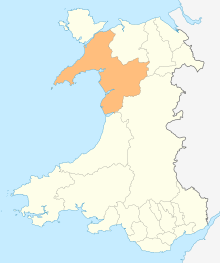Portmeirion
Portmeirion is a tourist village in Gwynedd, North Wales. It was designed and built by Sir Clough Williams-Ellis between 1925 and 1975 in the style of an Italian village, and is now owned by a charitable trust.
| Portmeirion | |
|---|---|
.jpg) The Piazza | |
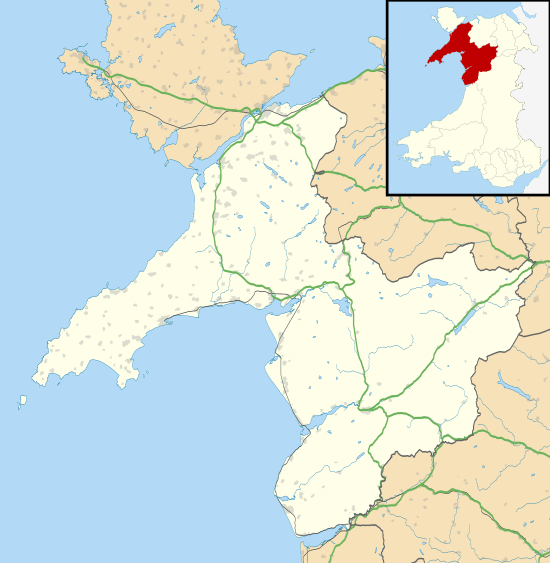 Portmeirion Location within Gwynedd | |
| OS grid reference | SH588370 |
| Community | |
| Principal area | |
| Country | Wales |
| Sovereign state | United Kingdom |
| Post town | PENRHYNDEUDRAETH |
| Postcode district | LL48 |
| Dialling code | 01766 |
| Police | North Wales |
| Fire | North Wales |
| Ambulance | Welsh |
| UK Parliament | |
| Senedd Cymru – Welsh Parliament |
|
The village is located in the community of Penrhyndeudraeth, on the estuary of the River Dwyryd, 2 miles (3.2 km) south east of Porthmadog, and 1 mile (1.6 km) from Minffordd railway station.
Portmeirion has served as the location for numerous films and television shows, most famously as "The Village" in the 1960s television show The Prisoner.
History
.jpg)
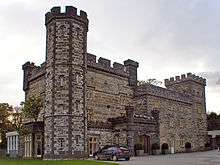
Sir Clough Williams-Ellis, Portmeirion's designer, denied repeated claims that the design was based on the fishing village of Portofino on the Italian Riviera. He stated only that he wanted to pay tribute to the atmosphere of the Mediterranean. He did, however, draw from a love of the Italian village stating, "How should I not have fallen for Portofino? Indeed its image remained with me as an almost perfect example of the man-made adornment and use of an exquisite site."[1] Williams-Ellis designed and constructed the village between 1925 and 1975. He incorporated fragments of demolished buildings, including works by a number of other architects. Portmeirion's architectural bricolage and deliberately fanciful nostalgia have been noted as an influence on the development of postmodernism in architecture in the late 20th century.
The main building of the hotel and the cottages "White Horses", "Mermaid", and "The Salutation" had been a private estate called Aber Iâ (Welsh: Ice estuary), developed in the 1850s on the site of a late 18th-century foundry and boatyard. Williams-Ellis changed the name (which he had interpreted as "frozen mouth") to Portmeirion: "Port-" from its place on the coast; "-meirion" from the county of Merioneth (Meirionydd) in which it was sited.[2] The very minor remains of a mediaeval castle (known variously as Castell Deudraeth, Castell Gwain Goch and Castell Aber Iâ) are in the woods just outside the village, recorded by Gerald of Wales in 1188.
In 1931 Williams-Ellis bought from his uncle, Sir Osmond Williams, Bt, the Victorian crenellated mansion Castell Deudraeth with the intention of incorporating it into the Portmeirion hotel complex, but the intervention of the war and other problems prevented this. Williams-Ellis had always considered the Castell to be “the largest and most imposing single building on the Portmeirion Estate" and sought ways to incorporate it. Eventually, with support from the Heritage Lottery Fund and the European Regional Development Fund as well as the Wales Tourist Board, his original aims were achieved and Castell Deudraeth was opened as an 11 bedroom hotel and restaurant on 20 August 2001, 23 years after Williams-Ellis's death, by the Welsh opera singer Bryn Terfel.
The village of Portmeirion has been a source of inspiration for writers and television producers. For example, Noël Coward wrote Blithe Spirit while staying in the Fountain 2 (Upper Fountain) suite at Portmeirion. George Bernard Shaw and H. G. Wells were also early visitors. In 1956 the village was visited by architect Frank Lloyd Wright, and other famous visitors have included Gregory Peck, Ingrid Bergman and Paul McCartney. In the late 1950s, ex-RAF photographer Stanley Long visited Portmeirion with the sole intention of creating a collectible stereoview series through VistaScreen; this would be exclusively available in the gift shop.[3] The village has many connections to the Beatles too. Their manager Brian Epstein was a frequent visitor and George Harrison spent his 50th birthday in the village in 1993. It was while Harrison was in Portmeirion that he filmed interviews for The Beatles Anthology documentary. Musician Jools Holland visited whilst filming for the TV music show The Tube, and was so impressed that he has had his studio and other buildings at his home in Blackheath built to a design heavily inspired by Portmeirion.
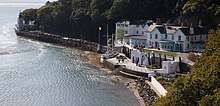
The grounds contain an important collection of rhododendrons and other exotic plants in a wild-garden setting, which was begun before Williams-Ellis's time by the previous owner George Henry Caton Haigh and has continued to be developed since Williams-Ellis's death.
.jpg)
Portmeirion is now owned by a charitable trust, and has always been run as a hotel, which uses the majority of the buildings as hotel rooms or self-catering cottages, together with shops, a cafe, tea-room, and restaurant. Portmeirion is today a top tourist attraction in North Wales[4] and day visits can be made on payment of an admission charge.
The village was the setting of the inaugural Festival N°6, which took place in September 2012 and featured headline acts Spiritualized, Primal Scream and New Order. Since then, this festival is celebrated each year in September at Portmeirion.
Architecture
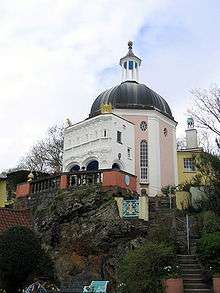
Architecture critic Lewis Mumford devoted a large part of a chapter of his 1964 book The Highway and the City to Portmeiron, which he called
an artful and playful little modern village, designed as a whole and all of a piece ... a fantastic collection of architectural relics and impish modern fantasies. ... As an architect, [Williams-Ellis] is equally at home in the ancient, traditional world of the stark Welsh countryside and the once brave new world of "modern architecture." But he realized earlier than most of his architectural contemporaries how constricted and desiccated modern forms can become when the architect pays more attention to the mechanical formula or the exploitation of some newly fabricated material than to the visible human results. In a sense, Portmeiron is a gay, deliberately irresponsible reaction against the dull sterilities of so much that passes as modern architecture today. ... [I]t is prompted by [the] impulse ... to reclaim for architecture the freedom of invention — and the possibility of pleasurable fantasy — it had too abjectly surrendered to the cult of the machine.[5]
.jpg)
Mumford referred to the architecture as both romantic and picturesque in Baroque form, "with tongue in cheek." He described the total effect as "relaxing and often enchanting" with "playful absurdities" that are "delicate and human in touch", making the village a "happy relief" from the "rigid irrationalities and the calculated follies" of the modern world.[5]
The houses Anchor, Arches, the hotel building, Lady's Lodge, the inside of the Pantheon and the vaulted ceiling of Gate House are decorated with murals and frescoes by the Frankfurt-born artist and friend of Clough Williams-Ellis Hans Feibusch.
Chronology of constructions in Portmeirion
| time | building |
|---|---|
| 19. century | existing buildings: White Horses, former blacksmith's shop; Castell Deudraeth (the hospital in The Prisoner); main building; gardener's house, stables |
| 1925 | conversion of the main building into a hotel, gardener's house becomes Mermaid; stables become Salutation |
| 1925/26 | Angel & Neptune |
| 1926 | Watch House, opening of the hotel |
| 1927/28 | Campanile; Prior's Lodging |
| 1928/29 | Government House |
| 1929 | Toll House |
| 1930 | Amis Réunis |
| 1930er Jahre | Hercules Hall; Pilot House; Battery Cottage, Dolphin; Fountain; Anchor, Trinity |
| 1933/34 | Chantry |
| 1937/38 | Camera Obscura |
| 1954 | Lighthouse (after the end of building restrictions during the war) |
| 1954/55 | Gate House |
| 1956/57 | Telford's Tower |
| 1958 | Bristol Colonnade; High Cloister (porch of the dome) |
| 1958/59 | Round House (residence of number 6 in The Prisoner), Bridge House |
| 1959 | Pantheon - dome, (the green roofing had to be removed after renovations in the 1990s due to fire protection requirements) |
| 1960 | Belvedere |
| 1961/62 | Chantry Row |
| 1962 | Playhouse |
| 1963 | Triumphal Arch; Gothic Pavilion |
| 1963/64 | Arches |
| 1964 | Gloriette Balkon |
| 1964/65 | Unicorn |
| 1966 | Villa Winch; Central Piazza (replacing a tennis court) |
| 1968/70 | Cliff House |
| 1977 | New Toll Booth |
| 1978 | Terrace, self-service restaurant |
| 1981 | The hotel was destroyed by fire |
| 1983 | Centenary Gazebo; Prisoner information centre opened in the Round House |
| 1988 | Reopening of the hotel after reconstruction |
| 1998 | Tudor Room, annex to the Hercules Hall |
| 1999 | Prisoner Information Centre closed; second pay kiosk opposite Toll Booth; Castell Deudraeth reopened as hotel after renovations. |
| 2001 | New Prisoner shop in the Round House |
| 2007 | Caffi Glas (The Blue Café), Italian restaurant (built 1950 as garages for guests) |
| 2016 | permanent chess set, built in remembrance of The Prisoner next to the central piazza |
Filming location
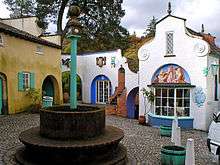
Television series and films have shot exterior scenes at Portmeirion, often depicting the village as an exotic European location. Examples of this include the 1960 Danger Man episode "View from the Villa" starring Patrick McGoohan, the 1976 four-episode Doctor Who story titled "The Masque of Mandragora" set in Renaissance Italy,[6]. The Christmas 1980 and final ever episode of Citizen Smith entitled Buon Natale was filmed partly in Portmeirion. In this episode, Wolfie and Ken visit Rimini where Wolfie's girlfirend Shirley works. In 2002 some scenes were filmed there for the final episode (at the time) of the TV series Cold Feet.[7] The town of Wiggyville in the Cbeebies series Gigglebiz is shot in Portmeirion as well. Just as well, the village of Llan-ar-goll-en in the Welsh preschool show of the same name on S4C, was shot there.[8]
Portmeirion has been the location for music videos and concerts. The 1980s Scottish band Altered Images used Portmeirion in their video "See Those Eyes". Siouxsie and the Banshees used Portmeirion as a setting in their 1987 recording of "The Passenger" for the "Laughing Prisoner" spoof. This video included various scenes from The Prisoner.
.jpg)
The Prisoner
In 1966–1967, Patrick McGoohan returned to Portmeirion to film exteriors for The Prisoner, a surreal spy drama in which Portmeirion played a starring role as "The Village", in which McGoohan's retired intelligence agent, known only as "Number 6", was incarcerated and interrogated, albeit in pleasant surroundings. At Williams-Ellis' request, Portmeirion was not identified on screen as the filming location until the credits of the final episode of the series, and indeed, Williams-Ellis stated that the levy of an entrance fee was a deliberate ploy to prevent the Village from being spoilt by overcrowding.[2] The show, broadcast on ITV in the UK during the autumn of 1967 and CBS in the US in the summer of 1968, became a cult classic, and fans continue to visit Portmeirion, which hosts annual Prisoner fan conventions.[9] The building that was used as the lead character's home in the series currently operates as a Prisoner-themed souvenir shop. Many of the locations used in The Prisoner are virtually unchanged after more than 40 years.
Because of its Prisoner connection, Portmeirion has been used as the filming location for a number of homages to the series, ranging from comedy skits to an episode of the BBC documentary series The Celts, which recreated scenes from The Prisoner. Other occasions include:
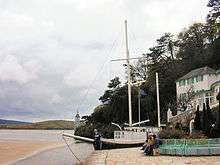
- In 1987 Jools Holland starred in a spoof documentary, The Laughing Prisoner, with Stephen Fry, Terence Alexander and Hugh Laurie. Much of it was shot on location in Portmeirion, and it included archive footage of McGoohan.
- Portmeirion, along with the Welsh village of Morfa Bychan, was used as the location for the filming of the Supergrass video Alright. The video includes numerous references to The Prisoner.
- Iron Maiden recorded a song called "The Prisoner" on their 1982 album, The Number of the Beast. In a documentary programme about that album (as part of the Classic Albums TV series), lead singer Bruce Dickinson wanders through the avenues of Portmeirion and describes how the song was written and how the band's manager obtained permission from Patrick McGoohan to use dialogue from the show in the song's introduction.
- The Channel 4 music programme The Tube also produced videos for XTC's songs "The Meeting Place" and "The Man Who Sailed Around His Soul" filmed in Portmeirion with the band wearing costumes from The Prisoner.
- In Series 12, Episode 13 of Wheeler Dealers the finished Caterham 7 is taken to Portmeirion to pay homage to The Prisoner, which featured the Lotus 7, the predecessor of the Caterham 7.
References
Notes
- Headley, Gwyn and Meulenkamp, Wim. Follies: a National Trust Guide Cape, 1986. p.156
- "Portmeirion" a BBC Wales documentary, 2006
- "Be Seeing You: Portmeirion, The Village from ITV's "The Prisoner", in 3D". Brooklyn Stereography. 22 September 2019. Retrieved 8 October 2019.
- "Archived copy". Archived from the original on 18 August 2006. Retrieved 26 August 2006.CS1 maint: archived copy as title (link)
- Mumford, Lewis. "From Crochet Castle to Arthur's Seat" (1962) in The Highway and the City New York: New American Library, 1964
- "The Welsh Connection: 5 Factoids about the Doctor and Wales". BBC. 1 March 2015. Retrieved 1 March 2015.
- "Portmeirion hosts Cold Feet finale". BBC News. 11 March 2003. Retrieved 17 September 2007.
- "Llan-ar-goll-en".
- "Number's not up for The Prisoner". BBC News. 3 September 1998. Retrieved 12 October 2010.
External links
| Wikimedia Commons has media related to Portmeirion. |
| Wikivoyage has a travel guide for Portmeirion. |

